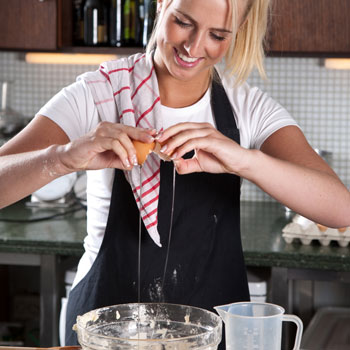
An important factor in being a good cook is to understand how to properly measure ingredients. With many recipes, the correct measurement of ingredients can either make or break a recipe. This is especially true in baking where every tiny teaspoon counts!
There was a time when cookbooks did not use terms like teaspoon, tablespoon or cup. Instead, they used phrases like "nice leg of spring lamb" or a "handful" of beans. Sometimes, a recipe would reference the size needed to another item, such as "the size of a walnut." Recipes would also indicate personal preference by terms like "sufficient" salt. After all, what is sufficient for one person may not be sufficient to another.
It wasn't until 1896 when Fannie Farmer introduced the "Boston Cooking-School Cook Book" when exact measurements were introduced. In the
Measurements in the
In the
Dry ingredients are measured by a pint, quart, peck (1/4 bushel), and bushel.
Generally speaking, measuring cups and measuring spoons are used when a recipe calls for a particular amount needed of an ingredient. Measuring cups range from 1/4 cup, 1/3 cup, 1/2 cup, and 1 cup. Measuring spoons range from 1/8 teaspoon, 1/4 teaspoon, 1/2 teaspoon, 1 teaspoon, and 1 tablespoon. Although these are the most typically used measuring devices, there are other measurements that can be found in the cup and spoon categories, usually found in specialty stores.
For many recipes to work, you want to stay as close to the listed ingredient measurements as possible. Improperly measuring an ingredient can ruin the recipe, especially in baking when you don't have the opportunity to go back and add more ingredients to cover your mistake or altering ingredients may impact the chemical reaction that occurs during baking.
Tips and Tricks to Measuring
When using dry ingredients like flour, baking power or soda or sugar, it helps to measure them in the appropriate cup (whether it calls for a tablespoon, 1/2 cup, 1 cup, etc.) and then using the straight edge of a knife, to level it off even with the top of the measuring cup. Start off by overfilling the measuring cup and spoon and then level it off. You can do this over a paper plate, which will make it easier to fold and pour the excess dry ingredient back into its container.
When measuring liquids in a liquid measuring cup, it's important to do so at eye-level, so that you get it right on the appropriate measuring line. If you are looking down into the liquid measuring cup, you may misjudge.
If you are using a measuring spoon, it's not a good idea to do it over the bowl you are mixing ingredients in. It's too easy to spill, so measure the ingredient off to the side and then pour into the bowl.
It's also important to pay attention to the way an ingredient is supposed to be cut. If a recipe calls for 1/2 cup of diced green peppers, you want to make sure that you have actually diced the green peppers, not just cut them into chunks. Some recipes may call for an ingredient to be chopped or minced, so again, pay careful attention to what is required and then make sure the ingredients are placed in the measuring cup so that they are even with the measurement line you are aiming for.
Measuring ingredients like peanut butter and lard can be tricky. Rub the inside of the measuring spoon or cup with a small amount of oil so that it's easier to scoop out of the cup or spoon. Just like with your dry ingredients, you should also level off these ingredients with the straight edge of a knife.
Non-Technical Terms in Measurement
Exact measuring is not always necessary in a recipe. If you are cooking a soup, stew, or stir-fry, it usually doesn't require exact measurements. Sometimes in cooking you will hear non-technical terms such as: dash, pinch and smidgen. Traditionally, these were known as very small amounts, although, exactly how much they equaled we didn't really know.
Since then, these non-technical terms have come to be more uniformly defined. A smidgen is 1/2 pinch or 1/32 teaspoon. Two smidgens equal one pinch.
We generally know a pinch as the amount you can get between your thumb and forefinger; however, now a pinch is 1/2 dash or 1/16 teaspoon. Two pinches equal one dash.
Originally, a dash was a term used when measuring liquids. Now the term has come to be used with both liquid and dry ingredients. A dash is 1/8 teaspoon. Eight dashes equal one teaspoon.
If these non-technical terms appeal to you, some companies do sell measuring spoons that measure a dash, a pinch and a smidgen.
Non-Measuring Recipes
There are some recipes that don't rely on measurement but rather on taste. If you are cooking a soup or a stew, it is always best to start with a small amount of an ingredient, taste, and then add more if necessary. You can't take back an ingredient once it has been poured but you can add more, so use caution when adding ingredients that don't require measurements.
A successful recipe depends on how you measure up. Remember that many recipes, especially baking recipes, require that exact measurements are used. Rushing through the process can ruin your entire meal so take time to measure carefully and accurately. If a recipe doesn't require exact measurements, remember to start off with just a pinch, a dash or a smidgen and then add as needed.
Measurements can make or break a recipe. Using these rules and tips of measuring you can be confident that your recipe will turn out just the way you planned.